Archive for the 'Board Game Review' Category
Posted by James (admin) on 20th November 2012
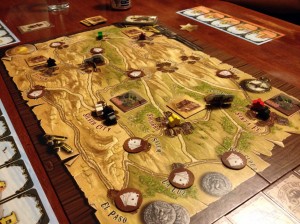 In Desperados, one player is the marshal trying to protect the Wild West from the other players who are all outlaws working together to rob banks, fix poker games and hold-up stage coaches. If the outlaws can gather a total of $4,000 for each outlaw player after 5 rounds, the outlaws win.
In Desperados, one player is the marshal trying to protect the Wild West from the other players who are all outlaws working together to rob banks, fix poker games and hold-up stage coaches. If the outlaws can gather a total of $4,000 for each outlaw player after 5 rounds, the outlaws win.
The gameplay uses an interesting hidden-movement game mechanic as the outlaws try to move to where the sheriffs and marshal are not located so they can steal money and avoid being arrested. (I’ll explain the game mechanic in a bit of detail as it’s the core of the game – it’s actually simple but requires careful explanation.)
GAMEPLAY
The board shows various towns and cities connected by roads – towns have poker game tiles (worth $300-$600), cities have bank tiles (worth $500-$3,200), and stagecoaches move to towns and cities along pre-determined routes (worth $800-$1,200 when robbed). Note that the tiles are random and values hidden so outlaws don’t know exactly what they’re worth.
Wooden figures on the board (meeple) show the locations of each outlaw, the marshal and the sheriffs (1 sheriff per outlaw player). Each outlaw and marshal player has a deck of cards: 1 card showing each town/city plus 1 saloon card. Each of the 5 rounds is split into a planning phase followed by an evaluation phase. Read the rest of this entry »
Tags: board game news, Board Games, board gaming, Desperados, Essen, Spiel 2012
Posted in Board Game Review, Board Games, Desperados, Essen Spiel 12 | 2 Comments »
Posted by James (admin) on 16th November 2012
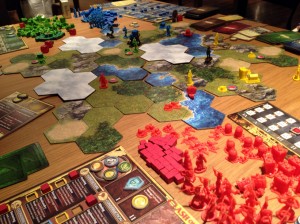
A player board can be seen at the bottom of the picture. Notice the cubes in the square holes marking the advances gained.
Clash of Cultures is a civilisation building game by the designer of Merchants and Marauders and this sole fact meant it was on my ‘must play’ list as Merchants & Marauders was a superb game. In Clash of Cultures, players start as rival tribes in corners of the realm with no technology. Over 6 rounds, the players explore the land, generate resources, build cities, create technologies, trade, potentially fight each other, and do whatever they can to be the most successful. At the end of the game, victory points (VPs) are scored for building cities (1VP per piece), advances in technology (1/2VP each), completing objective cards (2VP each) and building wonders (5VP each) – the player with the most VPs wins.
GAME
The board/map is made of tiles (each showing 4 hexes) of various types: water, mountains, barren, grassland, forest. Unexplored regions remain face-down until entered when a player turns the tile over and sometimes gets a choice on its orientation.
Players all start the same with 1 settler, the Farming and Mining advances and 1 basic city. During the game, cities can be improved by adding a port, academy, temple and/or fortress. The size of a city is equal to the total number of pieces – the bigger the size, the more resources it collects and influence it has; however, city size is limited by the number of cities you own so you can’t just have one super-city. A city that is happy functions like a city of 1 larger size; whereas, an angry city functions like a city of size 1. Read the rest of this entry »
Tags: board game news, Board Games, board gaming, Clash of Cultures, Essen, Spiel 2012, Z-Man Games
Posted in Board Game Review, Board Games, Clash of Cultures, Essen Spiel 12 | No Comments »
Posted by James (admin) on 13th November 2012
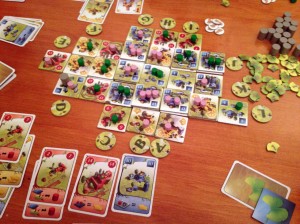
Ginkgopolis is by one of the designers I really like – Xavier Georges (Carson City, Royal Palace, Troyes and Tournay). Ginkgopolis is a game with the theme of futuristic, city building. As with many of Georges’ games, the game mechanic is a bit unusual (it’s actually relatively simple, although it may not seem so at first). As a result, I felt it important to explain the gameplay quite clearly (so please excuse the length of this review) because a brief outline would offer little insight.
GAME
At the start of the game, there are 9 building tiles in a 3×3 grid – 3 red, 3 yellow and 3 blue buildings with values 1, 2 and 3 – surrounded by lettered discs A-L. The initial card deck contains cards for each letter and each of the 9 starting buildings. Players start with some resources (cubes) of their own colour and some building tiles. During the game, the players will add building tiles to the 3×3 grid (on the outside as well as laying new tiles on top of existing ones). Players score victory points (VPs) when placing some tiles, and at game end for controlling areas plus bonus VPs based on cards they own. The player with the most VPs at the end of the game wins. Read the rest of this entry »
Tags: board game news, Board Games, board gaming, Essen, Ginkgopolis, Pearl Games, Spiel 2012, Xavier Georges, Z-Man Games
Posted in Board Game Review, Board Games, Essen Spiel 12, Ginkgopolis | No Comments »
Posted by James (admin) on 6th November 2012
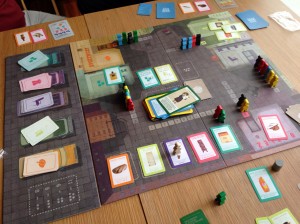 When someone suggests a game about queuing and shortages in Poland in the 1980’s, your first thought is probably to avoid eye contact and back away. However, Kolejka (which is Polish for ‘Queue’ and pronounced col-aay-ka) is actually a gem of a game which I hope gets the attention it deserves as it actually contains a great Eurogame as well as an interesting and fitting theme.
When someone suggests a game about queuing and shortages in Poland in the 1980’s, your first thought is probably to avoid eye contact and back away. However, Kolejka (which is Polish for ‘Queue’ and pronounced col-aay-ka) is actually a gem of a game which I hope gets the attention it deserves as it actually contains a great Eurogame as well as an interesting and fitting theme.
Players are each trying to obtain 10 goods listed on their objective cards – for example, 4 luxury goods, 3 pieces of clothing, 2 food and 1 electrical. The first player to collect all of their items wins, or the player that collects the most of their items by the end of the game.
Each round a few goods will arrive at some of the 5 stores. First, before knowing what will arrive where, players take turns adding any of their people (meeple) who are not in queues to the queues. Then, goods cards are revealed which determine how many goods arrive at which stores, e.g. 2 electrical items at the electrical store, 3 foods at the food store, etc. Read the rest of this entry »
Tags: board game news, Board Games, board gaming, Essen, Kolejka, Poland, Queue, Rebel.pl, Spiel 2012
Posted in Board Game Review, Board Games, Essen Spiel 12, Kolejka (Queue) | No Comments »
Posted by James (admin) on 2nd November 2012
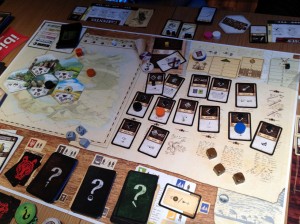 ‘Robinson Crusoe: Adventure on the Cursed Island’ is a co-operative game where players are on a desert island and must fight for their survival whilst trying to achieve a goal (depending upon the scenario being played).
‘Robinson Crusoe: Adventure on the Cursed Island’ is a co-operative game where players are on a desert island and must fight for their survival whilst trying to achieve a goal (depending upon the scenario being played).
Good co-operative games need two very important components. First, the players need to be given interesting/difficult choices so they feel they have input and are playing the game, not merely a passenger. Second, the game must create some random elements (like events) which aren’t too random that they don’t make sense or are overpowered, but also aren’t too predictable or small that they don’t make any difference. Back in the 80’s, Games Workshop released a solo-play game called Chainsaw Warrior which I always hold up as an example of how a game where you play against the game can be done badly. A card deck determined random events but you had little choice and was so random that you could just look through the deck and see if the card order meant you’s almost certainly win or lose. Read the rest of this entry »
Tags: board game news, Board Games, board gaming, Essen, Portal Publishing, Robinson Crusoe, Spiel 2012, stronghold
Posted in Board Game Review, Board Games, Essen Spiel 12, Robinson Crusoe | No Comments »
Posted by James (admin) on 26th October 2012
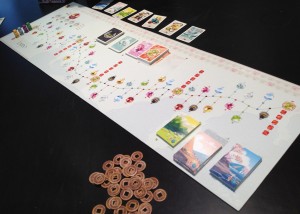 In Tokaido, players are travelling along a road visiting villages, seeing great vistas, visiting temples, staying at inns,etc. in order to earn victory points (VPs). The player with the most VPs at the end of the game wins.
In Tokaido, players are travelling along a road visiting villages, seeing great vistas, visiting temples, staying at inns,etc. in order to earn victory points (VPs). The player with the most VPs at the end of the game wins.
Players move along the road from left to right. On their turn, they can go to any empty space ahead of them (up to the next inn where they must wait for any other travelers to catch-up). Spaces at each location are limited (usually one or two spaces) so a player may not be able to visit a location if it is currently full of other travelers. This is very important because a player can never move backwards along the road.
So, you can rush ahead to ensure you land at a location you want to, but at the cost of never being able to visit any of the skipped locations on your way there. However, moving slowly means opponents may move into the locations you will want to so they could be full when it is your turn and you have to pass them by. The player who is furthest back is the player who moves next – so it’s not wise to move too far ahead of this last player as it will allow them to land on every location between themselves and the next player. Read the rest of this entry »
Tags: board game news, Board Games, board gaming, Essen, Funforge, Spiel 2012, Tokaido
Posted in Board Game Review, Board Games, Essen Spiel 12, Tokaido | 3 Comments »
Posted by James (admin) on 25th October 2012
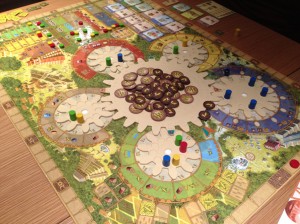 Tzolk’in is a worker placement game with a difference. In this Mayan-themed game, players have around 26 turns in which to impress the gods the most, i.e. earn the most victory points (VPs).
Tzolk’in is a worker placement game with a difference. In this Mayan-themed game, players have around 26 turns in which to impress the gods the most, i.e. earn the most victory points (VPs).
Each turn, players either place any amount of their workers or remove any amount of their workers. Players spend corn to place their workers on the cog(s) they desire taking the cheapest available slot (and the more workers you place in one turn, the more extra corn you must pay too). The unique part of this game is that workers are placed on small cogs which are located around a large central cog. Each turn, the large cog is turned and this turns all the small cogs which moves all of the workers on them along one step. When a player removes a worker, they get the benefit that the worker is next to and the longer a worker remains on a cog, the better the benefit when they are removed. Read the rest of this entry »
Tags: board game news, Board Games, board gaming, Czech Games Edition, Essen, Spiel 2012, Tzolk'in
Posted in Board Game Review, Board Games, Essen Spiel 12, Tzolk'in | 5 Comments »
Posted by James (admin) on 8th October 2012
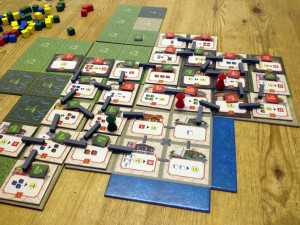 Singapore is an interesting mix of tile-laying and economic/resource management. Players are aiming to score the most victory points (VPs) which are earned through moving your worker(s) and using buildings. The board consists of several sections which can be combined in many ways which gives some variety in replay. Most squares on each board section show the cost of building on that square (£1-£4) . At the start of the game, there are 4 neutral buildings – every round players build one building and connect them to neighbouring buildings.
Singapore is an interesting mix of tile-laying and economic/resource management. Players are aiming to score the most victory points (VPs) which are earned through moving your worker(s) and using buildings. The board consists of several sections which can be combined in many ways which gives some variety in replay. Most squares on each board section show the cost of building on that square (£1-£4) . At the start of the game, there are 4 neutral buildings – every round players build one building and connect them to neighbouring buildings.
Players start with some money, 5 VPs and one worker. At the start of each round, a number of buildings are revealed (equal to the number of players plus one). Then, the player in last place takes one coloured marker from each player and places them on vacant lots that neighbour any existing buildings. These markers show where each player will build a building that round and the cost on the square dictates how much it will cost them.
Starting with the player in last place (and then going clockwise), players select one of the available buildings and pay the cost to build it on their marked square (leaving their coloured marker on it to show they own it). If a player can not afford the building cost, they must exchange 1 VP for £2 until they can (or they get the building for free if they have no cash and no VPs).
Read the rest of this entry »
Tags: board game news, Board Games, board gaming, Peer Sylvester, Singapore, White Goblin Games
Posted in Board Game Review, Board Games, Singapore | 4 Comments »
Posted by James (admin) on 3rd October 2012
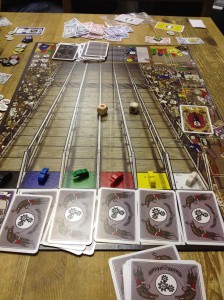 I’m usually a bit skeptical about horse racing games as I find they can be quite dry and/or overly complicated; however, Horse Fever surprised me. In Horse Fever, each player is trying to earn as many victory points (VPs) as possible.
I’m usually a bit skeptical about horse racing games as I find they can be quite dry and/or overly complicated; however, Horse Fever surprised me. In Horse Fever, each player is trying to earn as many victory points (VPs) as possible.
Each round, players get cards, make a bet, play cards on horses (without revealing them), make another bet, reveal the cards and then the race takes place. In the simpler version of the game that we played players are dealt cards – some cards help horses (they get a good start, move further when sprinting, etc.) and some hinder horses (they don’t move when in the lead, all beneficial cards are ignored, etc.) In the full version of the game, players buy cards instead of bring dealt them (which I think would be the best way) – you can also get target cards (extra VPs if you meet the conditions at the end of the game), assistant cards (discounts on some cards, regular income, etc.), stable cards (you own a horse and get cash if 1st, 2nd or 3rd), horse cards (on-going benefit to your horse if you have a stable). You can also take out loans and buy cards from other players. Read the rest of this entry »
Tags: board game news, Board Games, board gaming, Horse Fever
Posted in Board Game Review, Board Games, Horse Fever | 3 Comments »
Posted by James (admin) on 29th September 2012
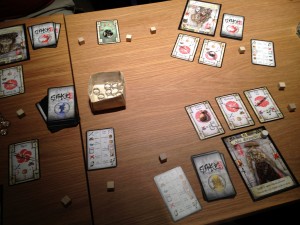 Sake and Samurai is a card-based game where players are each drunk samurai fighting each other to the last man. In front of each player is a card showing their samurai and there are some wooden blocks in between each player’s samurai to show how far apart they are. In the centre of the table is a cup holding a limited amount of clear beads (based on number of players) which represent the drink sake. When the game ends, the goal is to the drunkest remaining Samurai alive.
Sake and Samurai is a card-based game where players are each drunk samurai fighting each other to the last man. In front of each player is a card showing their samurai and there are some wooden blocks in between each player’s samurai to show how far apart they are. In the centre of the table is a cup holding a limited amount of clear beads (based on number of players) which represent the drink sake. When the game ends, the goal is to the drunkest remaining Samurai alive.
Players each have a hand of cards (events, weapons, minions, etc.) and each card can be used for any of its 4 values: Attack, Defence, Movement and Drinking. Players take turns carrying out one of four actions by using a weapon card already laid down or by playing a card from their hand:
- Attack: Play a card and add its attack rating to the rating of an equipped weapon card to give the total attack strength. (A samurai must be the right number of steps away to use a weapon.)
- Move: Play a card and move the samurai a number steps (equal to the card’s move rating) closer to a neighbouring samurai (and further from the other). This is done by moving the number of wooden markers from one side of the samurai to the other. Read the rest of this entry »
Posted in Board Game Review, Board Games, Sake and Samurai | No Comments »
 In Desperados, one player is the marshal trying to protect the Wild West from the other players who are all outlaws working together to rob banks, fix poker games and hold-up stage coaches. If the outlaws can gather a total of $4,000 for each outlaw player after 5 rounds, the outlaws win.
In Desperados, one player is the marshal trying to protect the Wild West from the other players who are all outlaws working together to rob banks, fix poker games and hold-up stage coaches. If the outlaws can gather a total of $4,000 for each outlaw player after 5 rounds, the outlaws win.









